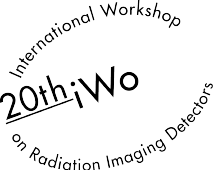Speaker
Description
We present the concept of a single-photon imager capable of detecting up to 10$^9$ photons per second with simultaneous measurement of position (<10µm resolution) and time (few tens of picosecond resolution) for each individual photon over an active area of 7 cm$^2$. The detector is based on a “hybrid” concept: a vacuum tube, with a transparent input window on which a suitable photocathode material is deposited, a micro-channel plate (MCP) and a pixelated read-out anode based on the Timepix4 ASIC (65nm CMOS technology) designed in the frame of the Medipix4 collaboration. A MCP with <10μm pore diameter will be used, operated at low gain (a few 10$^4$) and treated with atomic layer deposition, allowing a lifetime increase to >10 C/cm$^2$ accumulated charge. This detector will allow for the first time to fully exploit all the intrinsic excellent performance of a MCP, using a front-end electronics ASIC encapsulated in the tube with unprecedented performance. Timepix4 is an array of 512x448 pixels, 55µmx55µm each, with an active area of 28mmx25mm. It features 50-70 e- equivalent noise charge, a maximum rate of 1.2 Ghits/s, and allows to time-stamp leading-edge time and measure Time-over-Threshold (ToT) for each individual pixel. A weighted average of the cluster pixels position can be calculated using their ToT information, which allows to reach 5-10μm position resolution. The ToT information can also used to correct for the leading-edge time-walk in each pixel, and a timing resolution of few tens of picosecond is expected. The detector will be highly compact: the front-end electronics is encapsulated in the vacuum tube and allows local processing of the detector information, which are sent out of the tube in digital form. The Timepix4 architecture is data driven, producing 64 bits for each pixel hit, corresponding to a maximum data rate of 80 Gbps for 1.2 Ghits/s. A flexible design is conceived, with electro-optical transceivers linking the ASIC to a FPGA-based board, placed far from the detector, for the exchange of configuration and the collection of event data. The FPGA will perform serial decoding and send the data directly to a PC for storage using fast serial data links. These figures of merit will open many important applications allowing significant advances in particle physics, life sciences or other emerging fields where the detection of single photons with excellent timing and position resolutions are simultaneously required.
In this contribution we will present measurements performed on a prototype of such a hybrid photon detector, based on the first version of Timepix, developed by the Medipix collaboration. We will present its detailed characterization in terms of time and position resolution, measurements of its quantum efficiency using pairs of entangled photons and demonstrate its ability to reconstruct the trajectories of single high-energy electrons passing a scintillator (see Fig. 1). The challenges and prospects for an improved version of such a photon detector using Timepix4 will be presented in detail.

Fig. 1: Trajectory of a single 5 GeV electron passing a 4 mm x 4 mm x 4 mm plastic scintillator, reconstructed from single photons emitted along the trajectory which were detected at the same time from two different views with a Timepix-based hybrid photon detector. The values on the axes are given in pixels [px].
